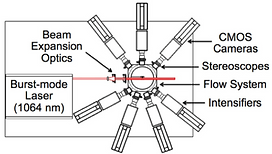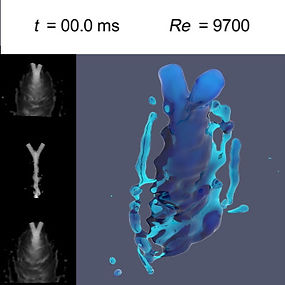Research
Rotating Detonation Engines (RDEs)


HAMR Heated Air-Breathing RDE Test Stand
Ignition and stable operation of an H2-air RDE. Traveling at 1.6 km/s, this detonation wave rotates about 1000 times in the blink of an eye.
Refill and Deflagration in CH4-GOx Rotating
Detonation Rocket Engines (RDREs)

Optical Setup
Rotating Detonation Engine Testing
Refill
Burned Gas
Deflagration
Det Wave Pre-Arrival

Fuel PLIF and Broadband Emission

RP-GOx RDRE

Aft-end Imaging
Multiwave Mode
-
RDEs have the potential to improve cycle efficiency and enable rapid combustion (top right) in a compact and lightweight package.
-
While simple in theory, the actual propellant injection, mixing, ignition and rotating detonation processes are highly dynamic and complex.
-
Several optically accessible and highly modular test rigs have been established (above and below) to enable in-situ MHz-rate diagnostics.
Refill & Deflagration in CH4-GOx RDREs
-
The 500 kHz hydroxyl planar laser-induced fluorescence (OH PLIF) data on the right, for example, show propellant refill, recirculation, deflagration, and contact burning prior to detonation wave arrival in a rocket RDE (Wang et al. 2024).
Spray-Wave Interactions in RP-GOX RDREs
-
300 kHz fuel PLIF of liquid Injection and broadband emission imaging to characterize detonation wave-spray interactions in an RP-GOx rotating detonation rocket engine are shown below (Wang et al. 2024)
Research Activities and Collaborations
-
MHz-rate imaging of premixed (Ayers et al. 2023) and partially premixed (Athmanathan et al. 2022) H2-air RDEs have also been conducted to evaluate the effects of mixing on detonation processes.
-
Research collaborations on a wide range of topics are taking place with Spectral Energies, LLC and the BEFAST lab at NCSU, as well as Nagoya University, Argonne National Laboratory, Georgia Tech, NASA, and other professors at Purdue University. This includes studies of chamber design, liquid and gaseous injectors, heat flux, ignition, plasma enhancement, etc.
RAMR Rocket RDE Test Stand
High-Enthalpy Aerothermal Flows for Air-Breathing Aviation
-
Next-generation propulsion systems seek to achieve substantially higher flight speeds and near-zero emissions.
-
The HEAT test rig (below) is a modular, optically accessible, high-temperature, high-pressure aerothermal flow tunnel used to study multistage combustion (right), spray evaporation and mixing, and ramjet combustion of conventional and alternative propellants.


High-Enthalpy Aerothermal (HEAT) Test Rig
High-Pressure Combustion
High-Pressure Combustion Physics and Chemistry of Alternative Fuels
-
Full-scale combustor test rigs are complex and cannot be used to isolate the physics and chemistry governing the behavior of alternative fuels.
-
New research involves experiments in the High-Pressure Experimental Laser-Based Imaging and Optical Spectroscopy (HELIOS) test rig to achieve pressures of 100 bar.


-
Laminar premixed, diffusion, and counterflow flame configurations can be used to evaluate combustion physics and chemistry of new alternative fuels.
Ultrashort-Pulse Laser Spectroscopy for High-Pressure Combustion
-
Pressure scaling laws for chemical kinetics in combustion systems require quantitative measurements of temperature and species concentrations.
-
Recent work has demonstrated the first hybrid fs/ps coherent anti-Stokes Raman scattering (fs/ps CARS) thermometry (right) and two-photon laser-induced fluorescence (TP-LIF) of CO and O atoms in high pressure flames.


-
Potential applications of ultrashort-pulse laser spectroscopy include measurements in plasmas and hypersonic flows.
Hypersonic Flows
-
Hypersonic flows are extremely complex, with turbulent boundary layers, shock interactions, non-equilibrium conditions, extreme gradients, and intense heat flux requiring knowledge of a wide range of species of interest.
-
Also of interest are the species and state properties within the supersonic combustion system and the exhaust nozzle.
Visualization of Turbulent Transition and Coherent Structures in Hypersonic Flows
-
The images shown to the right present the first MHz-rate nitric oxide planar laser-induced fluorescence (NO PLIF) to study laminar-to-turbulent transition in a hypersonic boundary layer at NASA Langley. Later work within the BAM6QT Mach 6 quiet tunnet at Purdue University includes measurement of CO PLIF as a product of surface ablation.
Molecular Tagging Velocimetry (MTV) of Boundary Layers in Hypersonic Flows





-
Femtosecond laser electronic excitation tagging (FLEET) is a form of MTV that was recently demonstrated within the Mach 6 quiet tunnel at Purdue University (above). This shows good agreement with the boundary layer velocity profile calculated from computational fluid mechanics.
-
Also of interest are measurements in the CUBRC hypervelocity tunnel, SwRI two-stage gas gun, Navy rail gun facility, UVA scramjet, Sandia shock tunnel, etc.
3D Imaging of Complex Flowields
High-Speed 3D Laser-Based Tomography of Turbulent Flames
-
Turbulent combustion is characterized by chemical reactions within highly-transient, 3D flowfields. which affect combustion efficiency, performance, emissions, and stability in propulsion and energy systems. This requires diagnostics that can track the spatially and temporally evolving physico-chemical behavior.



-
Through burst mode laser based volume illumination and wide-angle plenoptic imaging, it is possible to measure high-speed 3D combustion species, such as the soot volume fractions shown above, using tomographic reconstruction.
-
This approach has potential for application in many spatio-temporally evolving jets and turbulent flames.
High-Speed 3D Tomographic Imaging of Energetic Reactions
-
Energetic reactions within post-detonation fireballs are highly dynamic, shock-laden flows that carry multiphase (particulates and droplets) that are evolving and reacting at very short time scales.


-
Recent work has investigated the use of wide-angle relay plenoptic imaging to capture 3D time-evolving images of energetic reactions using tomographic reconstruction. The demonstration shown above was conduced in an e-match used for igniting energetic materials.
-
Ongoing work includes application to 3D measurements in multiphase blast fields.
High-Speed 3D X-ray Tomographic Imaging of Liquid Volume Fractions
-
X-ray imaging can readily penetrate optically dense regions of sprays and multiphase flows but has typically been limited to low repetition rates.
-
In recent work, an x-ray system with three lines of sight were used to collect multiple views simultaneously, followed by tomographic reconstruction.


-
The 3D images from a spray (right) show quantitative liquid mass fraction during jet impingement and breakup into ligaments and droplets at a rate of 10 kHz.
-
Other applications include in-situ evaluation within alternative propellant structures and formulations.

